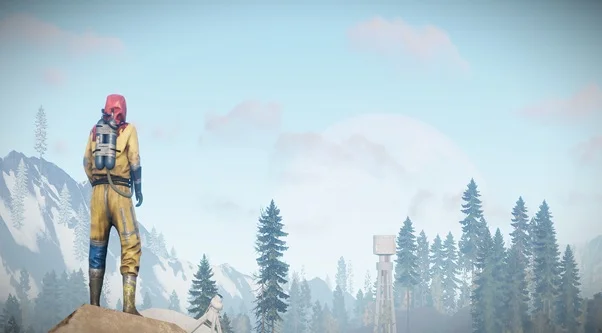Rust is an open-world survival multiplayer game that has been enjoying immense success since it was launched in early access in 2013
Since Rust is an online multiplayer game, latency or ‘lag’ is a very important factor that determines the overall gaming experience. Latency is the time that it takes for information to transit between the game server and your computer. Essentially, the higher the latency the more lags in the gameplay of the game are experienced.
Finally, when it comes to selecting the best Rust server hosting provider, the most crucial aspect is the server geographical location. Rust servers are located in different countries, the nearer the players are to the server, the less the latency is going to be. High latency is a big no-no in Rust.
Importance of Latency and Distance for Online Games
Latency is expressed in milliseconds (ms). The latency is acceptable if it is below 50ms, while below 30ms is considered excellent for online multiplayer games. However, as latency is above 50ms, problems like lag, rubberbanding, delayed actions, and similar things become obvious and annoying.
The rate at which data can be transmitted is mostly constrained by the distance that data has to cover. However, what this simply means is that at the speed of light, data still takes time to transfer from one location to another. This is why physical distance between the game server and players is the main cause of latency in the game.
In the case of a Rust server for European players hosted in America, latency could easily exceed 100ms because data needs to travel across the Atlantic Ocean using fiber optic cables.
At this level of latency, combat, gathering and other precision-based activities in Rust become unresponsive with frequent and periodic lags and delays. Picking server location correctly allows most players to have a ping below 50ms to avoid lagging in the game.
Selecting the Rust Server Hosting in the Proper Geographic Areas
While looking for Rust server hosting providers, make sure to note all the available server locations and select one close to your players. High-quality Rust server providers have server infrastructure in North/South America, Europe, Oceania, Asia, and sometimes Africa.
If you are an American player, you should connect to East or West Coast USA servers. Europeans should make sure they choose servers in the central EU locations including Frankfurt, London, Paris, or Amsterdam. For Russian players, it would be better to select only Moscow or St. Petersburg as the setting of the event, and for Brazilian users, it is better to focus only on São Paulo.
A good Rust server host will have low-latency server deployment that is ideal for most parts of the world. Nevertheless, if most players are located in a very narrow area and there are no servers nearby, the hosting provider should be prepared to add new location options at request. This makes it possible to achieve low levels of latency.
Be Careful of Incorrect Server Location Claims
For some low-quality game server hosts, it is a common practice to list servers in places where they do not possess any hardware at all. Instead, they lease space from third-party servers or route traffic through proxy networks to less expensive data centers thousands of miles away.
This enables them to guarantee low pings they can in no way fulfill. When the game server is hosted remotely even if the game developer wants the players to believe that the server is nearby, latency is significantly affected.
Specialized Rust Hosting Helps Get the Most Out Of Your Rust Server
Apart from location, the hosting infrastructure is another significant determinant of Rust server performance and latency. Popular cloud hosting services like Scalacube is designed to accommodate the high traffic load required by multiplayer game servers.
These often result in poor route optimization, poor up-time, and varied latency fluctuations. Rust server hosts are built to provide network solutions and hardware setups that are optimized for Rust gameplay on large scales. This involves the use of high-frequency Intel CPUs, SSD storage, DDoS protection and strategically directing the traffic for lower ping.
Thus, the distinction between a high-quality host and the reselling companies attempting to attract clients via unrelated and fake locations is crucial; however, the infrastructure capable of providing the functionality designed specifically for Rust should not be disregarded.
If the PC doesn’t meet these specifications and the network isn’t being managed properly, the servers in the same room can lag and freeze constantly.
Scalacube’s Global Server Network
Scalacube has a presence in North and South America, Europe, Australia, Asia, and Africa. Currently, there are 14 locations in total and Scalacube is available in 6 continents which means that it can place your Rust server closer to your players.
Scalacube also uses the best bandwidth suppliers in all locations to guarantee that servers in every site run optimally even at peak times. Server location options mean that you can obtain sub-30ms ping, no matter where people can join from.
You can get a taste of seamless multiplayer gaming experience by trying free-of-cost Minecraft server hosting by Scalacube.
Bottom Line
Besides technical skills, Scalacube also boasts its ability to make global reach possible for even small groups at an inexpensive cost. Our Rust servers begin at only $8/month and contain no player slot restrictions or additional charges.
Thus, Scalacube is cost-effective enough to deploy Rust servers in multiple geographical locations if necessary to achieve low ping across the world. It can hardly be matched by niche regional game hosts that only cover small geographic areas.
Scalacube offers all these advantages due to the economy of scale and advanced virtualization technologies that allow providing access to a top-quality worldwide infrastructure to Rust communities and clans at a fraction of the cost – low latency Rust servers for everyone.
For more related and helpful content, explore our blog here.









